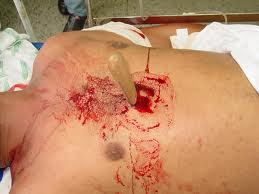Chest injuries
Chest injuries are difficult for the first aid provider to manage and casualties with these injuries should be referred to medical aid as a matter of priority. The major chest injuries encountered by the first aid provider are fractured ribs, flail chest and penetrating chest wounds.
Fractured ribs
Ribs are composed of successive layers of flat bone, which give the ribs their flexibility or 'spring'. When ribs fracture, often the 'spring' is reduced, rather than the entire bone being detached from the spinal column or the sternum. Rib injuries cause distress because the casualty has difficulty breathing.
Signs and symptoms:
- History of trauma to the chest
- Pale, cool skin
- Pain at the site, especially when breathing in
- Rapid pulse
- 'Guarding' of the injury
Care and treatment:
- Bind the upper arm on the injured side to the body
- Place the arm on the injured side in a 'collar and cuff' sling to act as a splint
- Seek medical aid
- Observe for breathing difficulties
Flail chest
Flail chest is an injury to the ribs where a section of the rib cage has been detached due to multiple fractures. Generally there is an associated collapsed lung (pneumothorax). Flail chest should be considered a life- threatening injury due to its complications.
Signs and symptoms:
- Pale, cool clammy skin
- Rapid, weak pulse
- Shallow, difficult breathing
- Paradoxical chest movements, where the injured area moves in the opposite direction to the rest of the chest
- Cyanosis (bluish skin)
- Pain, especially when breathing in
Care and treatment:
- Call Triple Zero (000) for an ambulance
- Apply a firm pad over the flail section
- Apply a firm bandage in place
- Position the casualty in a posture of comfort, usually sitting
- If unconscious, position on the injured side
- Reassurance
- Observe carefully for signs of breathing difficulties
Penetrating chest wound
A penetrating chest wound is where the object may still be in place in the wall of the chest or it may be an open wound left by the object, e.g. a stab wound or bullet wound. If the object is still in place DO NOT remove it, if it is too long or too awkward to manage (e.g. a tree branch), obtain urgent expert assistance and resist removing or cutting the object yourself.
 Signs and symptoms:
Signs and symptoms:
- History of the incident
- Object still in place
- Open wound in the chest wall (look for both entry and exit wounds)
- Pale, cool, clammy skin
- Rapid, weak pulse
- Rapid, shallow breathing
- Cyanosis (bluish skin)
- May be pain at the site
- Onset of shock
Care and treatment
- Call Triple Zero (000) for an ambulance
- If object is still in place, stabilise with a pad around entry wound
- Posture casualty in position of comfort
- Reassurance
- Observe for breathing difficulties
- If wound is open, apply plastic or a non-stick pad, taped on three sides only leaving bottom side un-taped to allow for air to escape from the chest. A gloved hand can be also be used to seal the wound until more suitable material is available
Choking
 A foreign body airway obstruction (choking) is a life-threatening emergency following the lodgment of a foreign object in the casualty's airway. In some instances, the object lodges at the epiglottis, the entry to the airway, but does not actually enter the airway itself. Both situations cause initial coughing, which is the body's reflex action to dislodge the object.
A foreign body airway obstruction (choking) is a life-threatening emergency following the lodgment of a foreign object in the casualty's airway. In some instances, the object lodges at the epiglottis, the entry to the airway, but does not actually enter the airway itself. Both situations cause initial coughing, which is the body's reflex action to dislodge the object.
- If an object is firmly lodged in the airway, coughing at least keeps it high in the trachea though may not expel it. However, coughing with an object at the entrance to the airway will generally cause it to be expelled.
- Should you encounter a person with an apparent obstruction who is coughing effectively, DO NOT SLAP them on the back.
- If the obstruction is at the entrance to the trachea, then reactions to the slaps may cause the person to inhale the object and cause complete obstruction.
- If a casualty appears to be in increasing distress, then the object may be totally obstructing the airway.
Partial obstruction
- Signs and symptoms Care and treatment
- Difficulty in breathing
- Wheezing
- Snoring sound
- Cyanosis (blue skin colour)
- In children and infants - flaring of the nostrils - in-drawing of the tissues above the sternum and in between the ribs
- Encourage the casualty to keep coughing
- If blockage has not been cleared call Triple Zero (000) for an ambulance
- Reassurance
Do not slap the casualty with a partial obstruction on the back.
Complete obstruction
Signs and symptoms:
- Unable to breathe, speak or cough
- Agitated and distressed
- May grip the throat
- Bluish skin colour
- Rapid loss of consciousness
Care and treatment:
Conscious casualty
- Position yourself to deliver back blows - stand slightly behind and to the side of the casualty - support the chest with one hand - lean the casualty well forward
- Deliver up to five firm back blows between the shoulder blades using the heel of the hand
- Check mouth and clear any obstructions that may have come loose after each back blow
- If back blows are unsuccessful deliver up to five chest thrusts - chest thrusts are given in a similar way to chest compressions but are sharper and delivered at a slower rate. Place your hand in the centre of the chest as for CPR
- Check mouth and clear any obstructions that may have come loose after each chest thrust
- Repeat back blows and chest thrusts if obstruction not relieved
Unconscious casualty
- Support the casualty carefully to the ground
- Call Triple Zero (000) for an ambulance
- Commence CPR